Capicola Recipe
This post may contain affiliate links. See my disclosure policy.
Succulent, superbly seasoned and flavorful, this easy baked Capicola recipe will take your Italian subs, sandwiches, pizza and snacking to a new level! This homemade capicola is easy to make and your efforts will be amply rewarded – it’s sure to become a favorite!
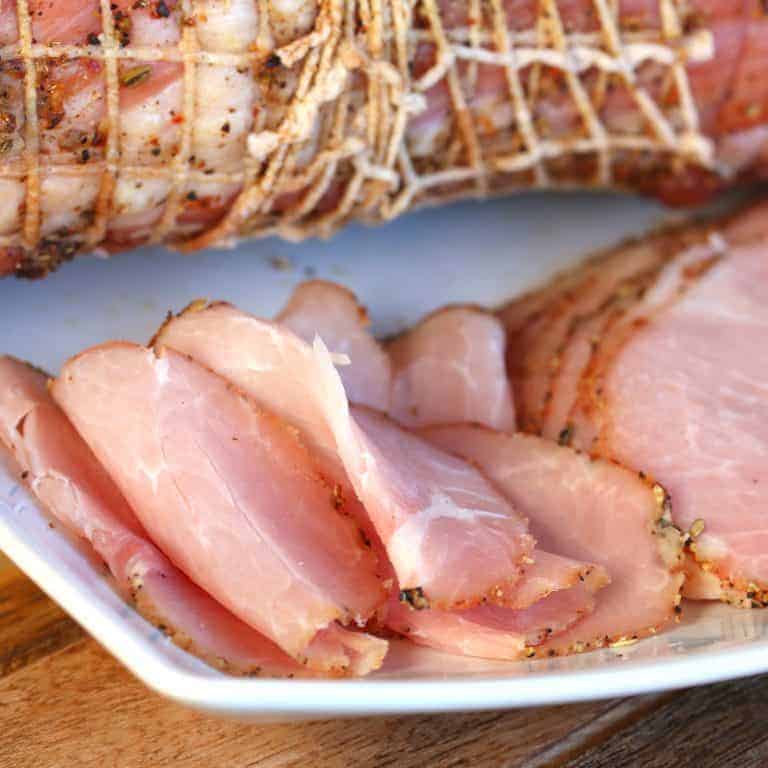
Do you enjoy a good sandwich from time to time? I mean a really good sandwich filled with succulent, high quality seasoned meat? Then you’ve GOT to make this baked Italian Capicola! And if you’ve always dreamed of making your own charcuterie but have either felt too intimidated or were put off by all the special equipment or all the work involved, this fabulous homemade capicola is for you! This is charcuterie-making that is easy, non-intimidating and thoroughly delicious!
What is Capicola?
Capicola (also known as capocollo) and coppa (more on that below) are both Italian charcuterie standards and use the same cut of pork. This specific cut of meat is highly marbled and comes from the neck of the pig (known as the coppa in Italy) and is selected because of it’s a near perfect ratio of 30% fat to 70% lean. This cut is commonly cooked/baked as well as dry-cured to create two different forms of highly popular charcuterie. This recipe is for baked capicola and is inspired by Olympic Provisions’ version.
What is Coppa?
Coppa (named after the cut of meat) is the dry-cured version of capicola. The meat is prepared in a special brine and hung to dry for approximately 2 months depending on its size in a temperature- and humidity-controlled environment where it becomes dry-cured. The coppa is then sliced very thinly (similar to prosciutto). The flavor is complex and flavorful, the texture delicate and almost melt-in-your mouth. Below is a dry-cured coppa I made a few months ago.
Today I’m sharing the cooked (not dry-cured) version of coppa: Capicola. The term capicola is often used interchangeably to also refer to the dry-cured version, so it can be a little confusing. We’re going to use the term capicola throughout the rest of this tutorial to refer to the cooked version.
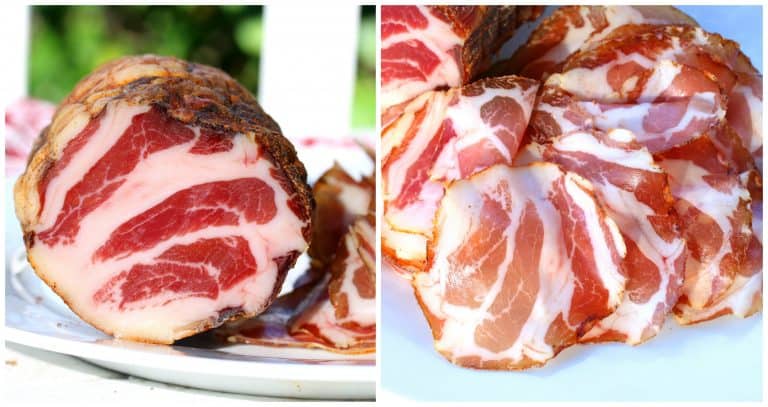
What You’ll Need
For this tutorial I’m also using a regular pork loin in the event that you have trouble locating the traditional coppa cut of pork (it can be difficult to find butchers who are knowledgable in European cuts, especially less common ones used for specialty charcuterie). It lacks the marbling of the traditional coppa cut and so won’t be as tender/moist but it still thoroughly delicious.
The ingredients for making capicola are minimal and (if you’re just using pork loin) you only need two items you normally may not have in your kitchen: Pink curing salt and size 24 meat netting. The pink salt helps the meat retain its appetizing pink color (instead of just looking like a brownish-gray pork roast once it’s cooked) and the net helps the meat retain its shape while cooking so you can get those beautiful slices.
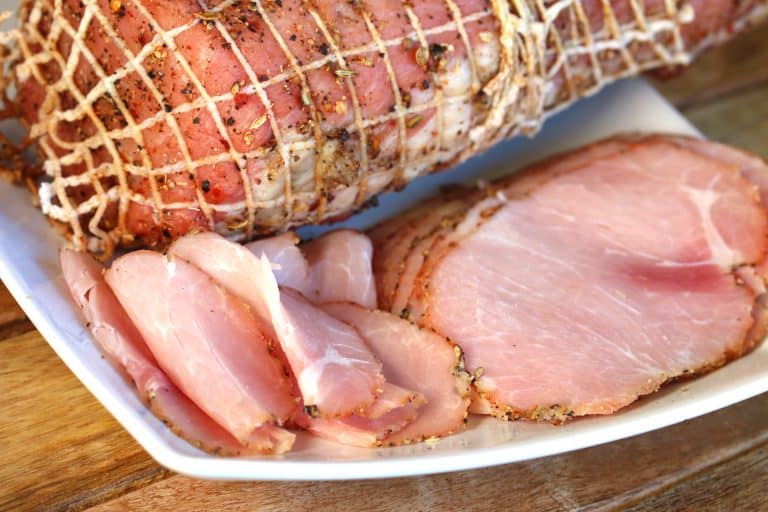
The process is very easy, there’s frankly very little that could go wrong, and your friends and family will think you’re an absolute pro! Make some delectable Italian subs using this capicola, add some cheese and some homemade Giardiniera if you like (amazing stuff!), and you’ve got one seriously delicious sandwich! It’s also fabulous on pizza.
Making your own coppa is also extremely cost-effective. Coppa in the specialty deli (if you’re lucky enough to find it) comes with a hefty price tag. You can make your own at a fraction of the cost.
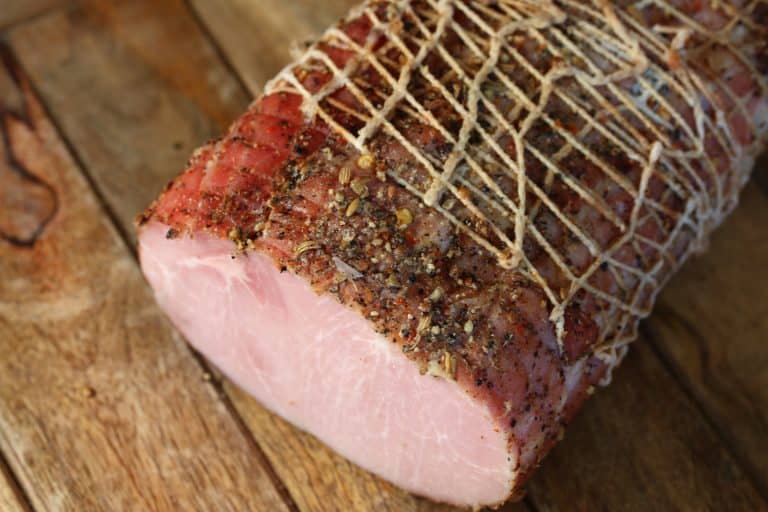
Homemade Capicola Recipe
Let’s get started!
First we’re going to make the cure for our pork. Place the sea salt, sugar, red pepper flakes and pink curing salt in a coffee/spice grinder or use a mortar and pestle to grind them. (It is essential that the pink salt is evenly distributed in the rub.)
Place the pork in a large bowl or on a work surface and massage the rub into the pork, making sure to get every nook and cranny.
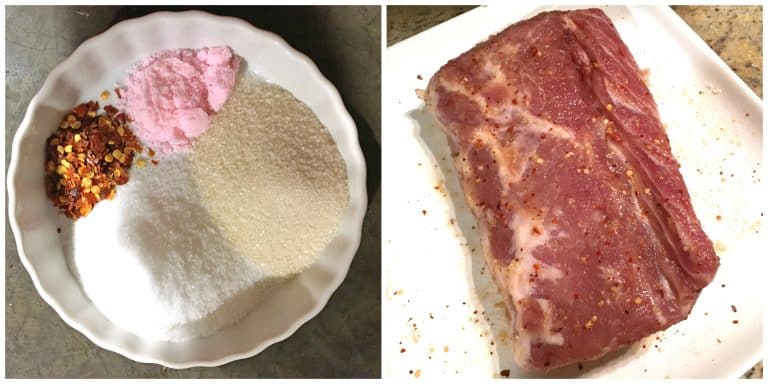
Wrap the pork tightly in plastic wrap and refrigerate it for 5 days. After 5 days flip it over so the bottom side is up and refrigerate it for another 5 days.
After 10 days unwrap the meat. It will be firmer to the touch. Thoroughly rinse it under cold water to remove all the spices and set it aside while you prepare the final rub.
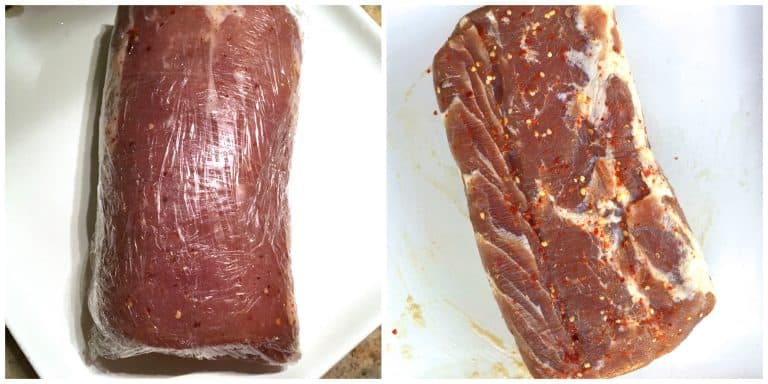
To make the rub, place the fennel seeds, coriander seeds, anise seeds, red pepper flakes and black peppercorns in a coffee/spice grinder or use a mortal and pestle to grind the spices until you get a coarse rub. Lightly blot the pork with a paper towel.
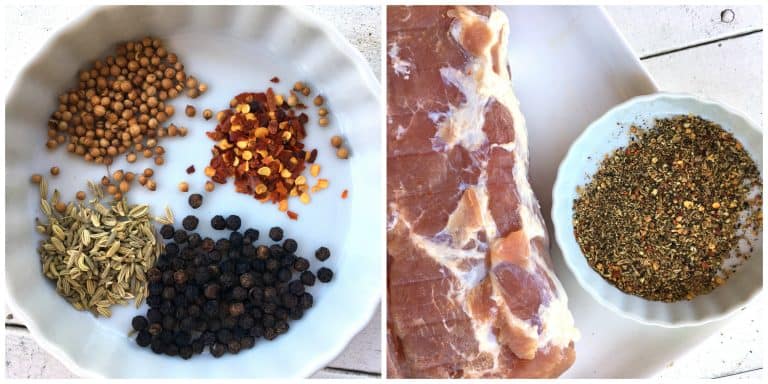
Spread the rub out onto a plate or work surface and roll the pork in it, coating all sides. Use up all the spice rub to coat the meat.
Next you’ll need a #24 netting roll. Cut a piece of netting off the roll that is a few inches longer than your capicola.
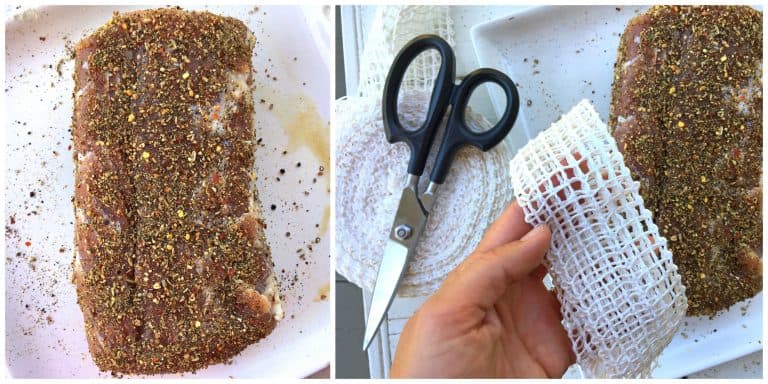
Stretch the netting and feed the capicola through it (unless you have a ham-stuffing funnel, it’s easiest to do this with two people).
Preheat the oven to 250 degrees F. Fill a pan up with water and place it on the middle rack of the oven. This will create humidity as the pork cooks to keep the pork moist. Place the capicola on a roasting pan fitted with a wire rack and place the pan on the top rack of the oven. Cook the capicola for 1 hour, then turn the pork over so the bottom side is up and bake it for another hour or until the internal temperature reaches 145-150 degrees F. Don’t overcook or the meat will be dry.
BE PATIENT, IT’S NOT READY TO EAT YET! Remove the capicola, place it on a plate and refrigerate uncovered for 4 hours.
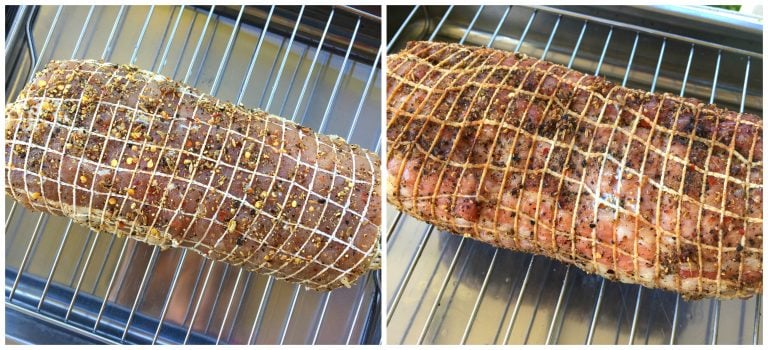
At that point your homemade Italian capicola is ready to eat! Slice it thinly and enjoy it on your sandwiches, pizzas or eaten on its own!
If you want very thinly sliced meat like the deli meat you buy in the store, you’ll need a meat slicer like this Chef’s Choice Electric Meat Slicer.
We love to make Italian subs by adding some capicola, cheese and homemade Giardiniera – it’s out of this world!
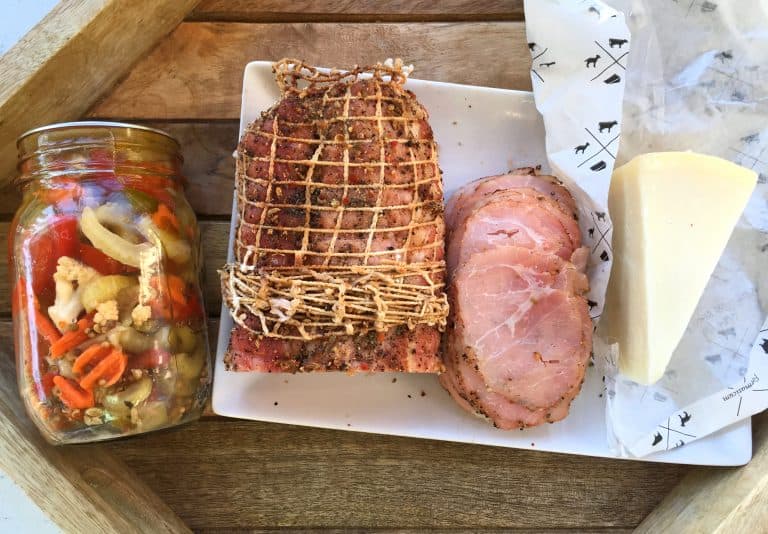
To store, keep it wrapped tightly in plastic wrap in the refrigerator where it will keep for up to 3 weeks.
Sliced capicola can also be frozen for up to a couple of months.
Enjoy!
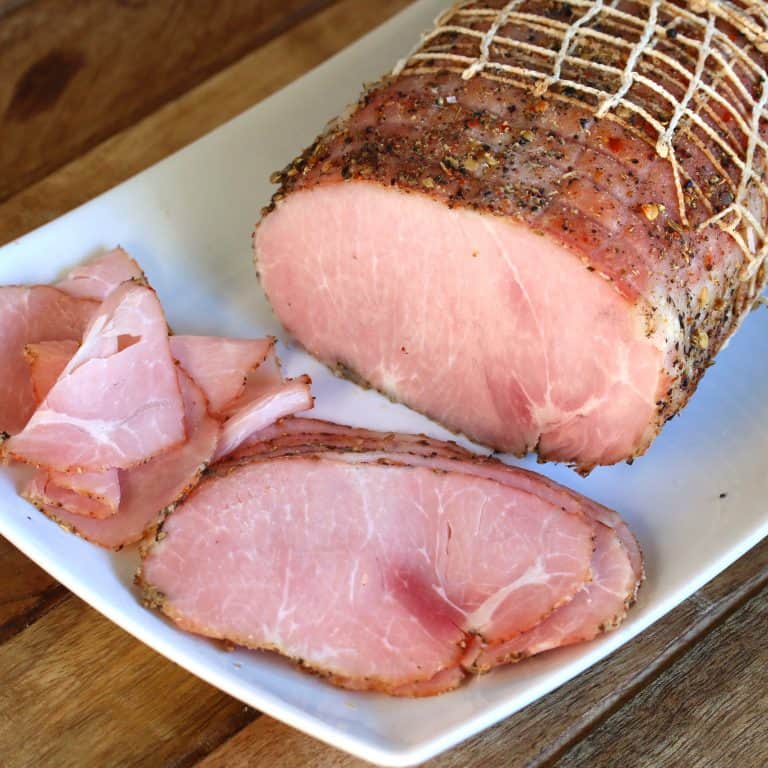
For more adventures in homemade charcuterie be sure to try my:
- Smoked Ham
- How to Make Bacon
- Capicola
- Porchetta
- Gravlax
- German Bratwurst
- Bangers
- Pork Rillettes
- Smoked Cheddar Sausages
- Breakfast Sausage Links
- Italian Sausage
Save This Recipe
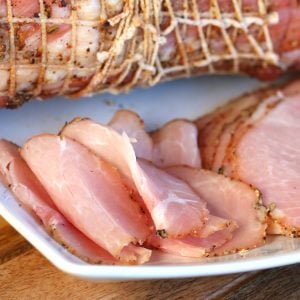
Capicola Recipe
Ingredients
- For the Curing Rub:
- 3 pounds pork coppa or pork loin (coppa is the traditional and preferred cut (we highly recommend it if you can get one from your butcher), see blog post for description)
- 2 1/2 tablespoons sea salt
- 2 tablespoons sugar
- 1 teaspoon crushed red pepper flakes
- 1 teaspoon curing salt #1 (aka Prague powder) (this is essential for maintaining the pink color of the meat as opposed to brown/gray once it’s cooked)
- For the Seasoning Rub (feel free to tweak according to preference):
- 1 tablespoon coriander seeds
- 1 tablespoon fennel seeds
- 1 1/2 teaspoons black peppercorns
- 3/4 teaspoons anise seeds
- 1/2 teaspoon red pepper flakes
- You’ll also need:
- size 24 meat netting
Instructions
- To make the cure, place the sea salt, sugar, red pepper flakes and pink curing salt in a coffee/spice grinder or use a mortar and pestle to grind them. (It is essential that the pink salt is evenly distributed in the rub.)Place the pork in a large bowl or on a work surface and massage the rub into the pork, making sure to get every nook and cranny.Wrap the pork tightly in plastic wrap and refrigerate it for 5 days. After 5 days flip it over so the bottom side is up and refrigerate it for another 5 days.
- After 10 days unwrap the meat. It will be firmer to the touch. Thoroughly rinse it under cold water to remove all the spices and set it aside while you prepare the final rub.To make the rub, place the fennel seeds, coriander seeds, anise seeds, red pepper flakes and black peppercorns in a coffee/spice grinder or use a mortal and pestle to grind the spices until you get a coarse rub. Lightly blot the pork with a paper towel.Spread the rub out onto a plate or work surface and roll the pork in it, coating all sides. Use up all the spice rub to coat the meat.Next you'll need a #24 netting roll. Cut a piece of netting off the roll that is a few inches longer than your capicola.Stretch the netting and feed the capicola through it (unless you have a ham-stuffing funnel, it's easiest to do this with two people).
- Preheat the oven to 250 degrees F. Fill a pan up with water and place it on the middle rack of the oven. This will create humidity as the pork cooks to keep it moist. Place the pork on a roasting pan fitted with a wire rack and place the pan on the top rack of the oven. Cook the capicola for 1 hour, then turn the capicola over so the bottom side is up and bake it for another hour or until the internal temperature reaches 145-150 degrees F. Don't overcook or the meat will be dry.Be patient, it's not quite ready yet! Remove the capicola, place it on a plate and refrigerate uncovered for 4 hours.
- At that point your homemade Italian capicola is ready to eat! Slice it thinly and enjoy it on your sandwiches, pizzas or eaten on its own! (For professional looking deli meat slices, use an electric meat slicer.) To store, keep it wrapped tightly in plastic wrap in the refrigerator where it will keep for up to 2 weeks.The sliced capicola can also be frozen for up to a couple of months.
Nutrition
Originally published on The Daring Gourmet March 6, 2019 / Recipe inspired by Olympia Provisions



















Hi, please can you confirm:
At step 3, do you refrigerate straight from the oven or do you let it cool to room temperature ?
Hi Jan, let it cool first.
I just made this & while I tweaked the seasoning (more red pepper less anise) & tied it with twine because I didn’t have netting. It came out so amazing & was absolutely delicious! Thank you so much for this recipe. I have a feeling it is going to be on a regular rotation in our home.
I’m so happy you enjoyed it, Katerina, thank you very much for the feedback!
Ever try this with venison
Hi Paul, I have not but if the same cut from the deer is likewise well-marbled you can certainly use it.
Kimberly, This was great and well liked by everyone that tried it. I made some additions to the rub and baked covered and turned for the first hour to increase moisture before baking second hour uncovered. Turned out lovely. I used pork loin and wondered if I could do the same with beef loin? Thankyou !!!
Thank you, Al, I’m so glad you enjoyed it! I haven’t made this with beef loin but it’s certainly worth a try and I’d love to know what you think after comparing the two.
Hi Kimberly,
I love your Spice combination & this is about my 4th Capicola. I tweeked the recipe a bit & upped the red pepper & added Paprika, I also used Pink Himalayan salt in place of the salt called for.
I’m not sure who wants to go there but I like to experiment so only because my Instantpot has a Sous Vide setting I decided to go there with it. I set it at 135 degrees and a 4 pound loin took about 3½ hours which at that point it was about 131 or 132 degrees. After about 2½ hours you will have to check the temperature occasionally.
From there I put it into my air fryer set on bake at 150 degrees just to dry the outside of the loin which will bring the temp up a little more. From there a cool down & into the refrigerator to chill.
I am fortunate enough to have a meat slicer (thrift store find) and I slice it super thin, I could live on this stuff!
Thank You for the recipe!
Fantastic, Cathy, thanks so much! Thanks also for sharing your insights on the sous vide and IP method!
THANK YOU!
I was wondering what your thoughts are on maybe a pinch or so of Black Cardamom in the seasoning stage. I’m wondering if it would pair with this & I sure don’t want to ruin it,
I was intrigued by Cardomom & finally bought me a sample of it but it has a smoky menthol like smell to it.
It does have a smoky menthol quality to it and I absolutely love it in my Indian dishes. I’m slightly hesitant about it in the capicola…but it could end up being one of those unexpectedly nice pairings. If you boldly give it a go let us know what you think! :)
italians add 4 garlic,1 bay leaf,1t. juniper berries,1/4 t. nutmeg.I used 3 pounds pork shoulder already tied. Great recipe,Thanks.
Looking forward to trying this soon! I’m guessing that this more along the lines of a sweet capicola as there isn’t a ton of pepper flakes. Any recommendations for those that like the hot capicola? And what do you think about using a chunk of pork shoulder instead of the loin? I may try one of each as the shoulder has so much more marbling and should get closer to the actual coppa texture, but I’m guessing it will slice up a little uglier.
Hi Phil, yes, if you prefer it hot just add pepper flakes. And yes, using shoulder won’t slice as nicely or hold shape but will certainly taste great!
Made this using pork cachoa (neck) & it turned out brilliantly. I didn’t have the anise seed so subbed it with caraway seeds, I found the ham had a little too strong a liquorice spice so will cut back the caraway & fennel seeds the next time I try it, which will be soon because there is no way this will last more than a few days as our kids love it too. I also didn’t have the netting & was pleasantly pleased at how well the pork held its shape without it. One last forced change to the recipe, due to my oven breaking a few days before I was due to cook the ham I had to use my instant pot (HP 45mins, NPR) but it still tastes amazing. Thank you for such a great recipe.
Fantastic, Sandra, I’m so glad it was a hit! Thanks so much for the feedback!
All I can say is that I am now on number 12 three in yesterday three in today 6 last week I used cushion Pork! Thank you so much tastes Delicious !!!!
Awesome, Eddie, I’m so glad you like this recipe, thank you!
what would happen if i smoked it to 150 instaed of the oven method
Hi Justin, you can certainly use that method, it will of course have the smoked flavor and there is a greater risk of the meat being dry.
What color is the meat supposed to be? Mine is partly brown and I’m a little nervous. I did use the pork loin because I wanted something leaner but now I’m wondering if less fat means less preservation.
Hi Lisa, it should be a pleasant pink color (e.g. like Canadian bacon). The fat content does not effect the color; if yours is brown then it sounds like the right kind of curing salt (Prague powder #1) wasn’t used which is what keeps the meat pink or if the right curing salt was used it sounds like it wasn’t ground with the spices to ensure even distribution.
Hi
This receipe look nice.
I will try.
For the ten days wrap, ca we put the meat in a vacuum bag?
Hi Maxime, yes you can! Some people prefer to do that to prevent the liquid from leaking in regular ziplock bags.
The recipe sounds great as I have made capicola before but using the dry method and I have been searching for a recipe like this for along time. Everything looks simple enough but I have one question about putting it in the netting. The procedure does not say whether you leave the ends open or do you tie them? Otherwise I can’t wait to do this.
Hi Nicholas, unlike the dry-cured type since this version won’t be hanging up there’s no need to tie it. Happy cooking and please let us know what you think!
Thank you Kimberly for your clarification. I am currently out of the Prague salt and am waiting for some to arrive. I think this is the recipe I have been searching for, for a long time. I will let you know in a month or so how it turns out although I am very optimistic that it will turn out perfect
I look forward to hearing what you think, Nicholas. Happy cooking! :)
Kimberly, I made two capicolas and they came out wonderful. I also passed the recipe to three of my son’s and my brother and they have made it and all have turned out great. At the present time I have one in the refrig on its second 5 days and will be finishing this coming monday. The fennel is a little over-powerering and I left out the anise seeds. This time I am going to eliminate the red pepper and use cayenne pepper for a little more heat. Absoutely wonderful recipe
I’m absolutely thrilled to hear that, Nick, thanks so much!